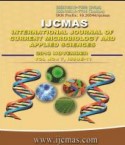


 National Academy of Agricultural Sciences (NAAS)
National Academy of Agricultural Sciences (NAAS)

|
PRINT ISSN : 2319-7692
Online ISSN : 2319-7706 Issues : 12 per year Publisher : Excellent Publishers Email : editorijcmas@gmail.com / submit@ijcmas.com Editor-in-chief: Dr.M.Prakash Index Copernicus ICV 2018: 95.39 NAAS RATING 2020: 5.38 |
During vermicomposting, decomposition of organic matter is mostly carried out by the aerobic microbes, facilitated by the earthworms. Light, an important ecological factor can penetrate up to 3-4 cm into surface soil or organic substrates and therefore is expected to influence the biological function of microbes during decomposition. This study reports the effect of low intensity colour lights on microbial population and exoenzyme activities along with changes in certain soil chemical parameters such as pH and organic carbon in semi-decomposed organic substrate (cattle dung) inoculated with the earthworm Eudrilus eugeniae over an incubation period of 42 days. The results indicated that darkness provide the most suitable environment for maximal bacterial population and activities of the enzymes, invertase, amylase and cellulase. The least population of bacteria was observed in the substrate under white light and red lights whereas blue and green lights indicated relatively higher bacterial population and enzyme activities. The maximal depletion in organic carbon was recorded in substrate in dark and the minimal in white light. Soil pH indicated noticeable decline in the substrate exposed to white and red lights. The study thus indicated that darkness provides the most favourable environment for maximal bacterial growth, exoenzyme activities and percent organic carbon reduction in earthworm inoculated organic substrate.
 |
 |
 |
 |
 |